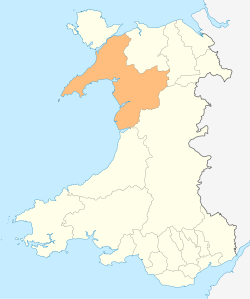Cwm-y-glo
| |
|---|---|
 Capel Tabernacl | |
Location within Gwynedd | |
| Population | 995 |
| Language | Welsh (72.1%) |
| OS grid reference | SH551626 |
| Community | |
| Principal area | |
| Country | Wales |
| Sovereign state | United Kingdom |
| Post town | CAERNARFON |
| Postcode district | LL55 |
| Dialling code | 01286 |
| Police | North Wales |
| Fire | North Wales |
| Ambulance | Welsh |
| UK Parliament | |
| Senedd Cymru – Welsh Parliament | |
| Website | https://llanrug.cymru/ |
Cwm-y-glo is a small village in Wales, 4+1⁄2 miles (7 km) east of Caernarfon, between Llanberis and Llanrug. It is in the Dwyfor Meirionnydd UK constituency, the community of Llanrug, and the Gwynedd Council electoral ward. Cwm-y-glo ward includes Ceunant and Pont-rug and has a population of around 1,000. [1]
Contents
The focus of the village is on the original roadway, now bypassed by the A4086 road, which follows the approximate line of the former railway.
To the east of the village lies the flood plain of Afon Rhythallt (an extension of the Afon Seiont), and consequently some houses on the eastern side of the old road (which lie below the level of the main road) suffer flooding.
The village is mainly residential, but has several shops and small businesses. Menter Fachwen is a local charity offering work to adults with disabilities.
The community is policed by Llanberis and has a dedicated Community Beat Manager.

